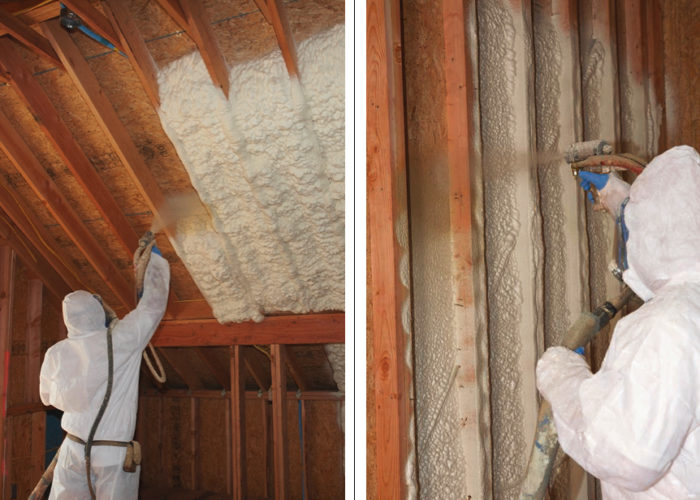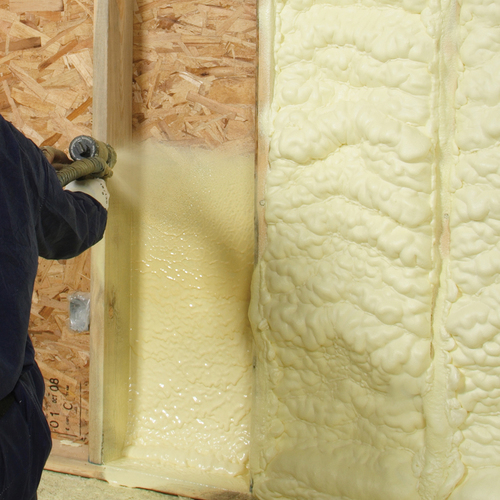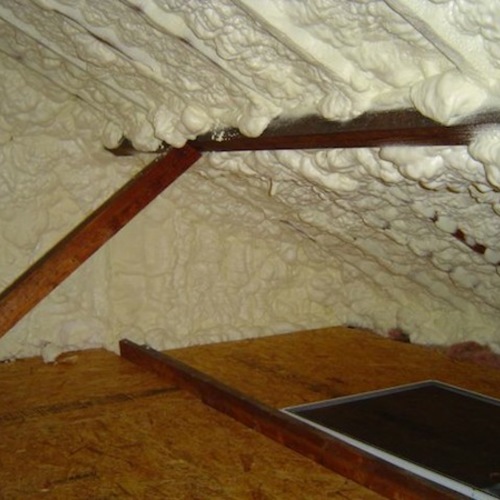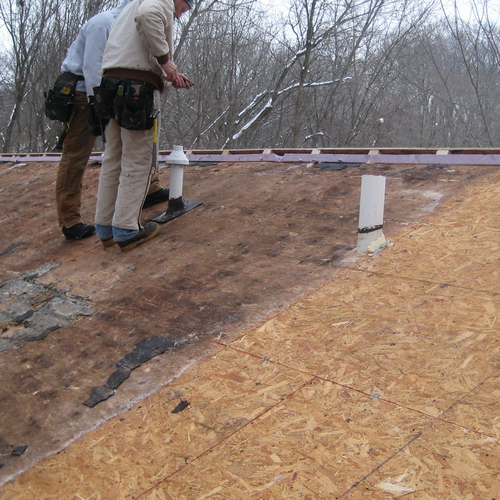
Everyone agrees that spray polyurethane foam does a great job at reducing air leakage. But which type of insulation makes the most sense: open-cell foam or closed-cell foam?
GBA presents two spray-foam experts — Jim Coler, the owner of Coler Natural Insulation in Ionia, New York, and Neal Ganser, a spray-foam consultant from Bozeman, Montana — who explain the advantages of the two main types of spray foam insulation.
Benefits of open-cell spray foam
by Jim Coler
When shopping for spray foam insulation, many builders and homeowners are uncertain whether to choose an open-cell product or a closed-cell product. In my opinion, the choice is clear: for above-grade residential applications, the best choice is usually open-cell foam. In most cases, open-cell foam will be more economical, more flexible, and more forgiving with moisture than closed-cell foam. Read more…
Benefits of closed-cell spray foam
by Neal Ganser
Replacing long-obsolete insulation materials with closed-cell or open-cell spray polyurethane foam is a big step in the right direction for energy efficiency. Of the two types of foam, it is closed-cell foam that truly answers all of the building envelope’s requirements for long-term sustainability. Compared to open-cell spray foam, closed-cell foam has a higher R-value and is less vapor-permeable. Read more…
Weekly Newsletter
Get building science and energy efficiency advice, plus special offers, in your inbox.















7 Comments
Downsides to Spray Foam
Spray foam can be a shortcut to a good air barrier(air control layer).
A few downsides:
1. Spray foam alone does not address thermal bridging.
2. Spray foam is extremely expensive which makes it not-so-practical for achieving high R-value assemblies.
3. Open cell foam can create a large amount of cubic waste (landfill)
a few more comments/questions
Interesting dialogue:
RE: HFC agent
Last I recall, the blowing agent for closed cell is HFC-245fa, and it has a global warming potential of roughly 800x CO2. I'm not going to ask about CO2 payback times, because it's pretty relative to climate conditions (and even those are moving target!). What are the standard mixtures for closed cell foam? How many lbs of HFC per volume of foam? Anyone have any insight?
Comment about closed cell workability:
a challenge/frustration we've had with closed cell: cutting down or slicing off any overspray is hard work!! The stuff is rigid, just like they describe, and takes some elbow grease to cut down. All the more motivation to not overspray. In its application, the closed cell was worth it as an important part of moisture management. A good option to have!
Agro-based additives trend:
Yes, I've seen the various agricultural based stuff. A couple of current frustrations:
1. Our local code enforcers aren't convinced that the additives aren't bug food and therefore won't allow it. We know the rest of the spray foam is pretty much oil-based and not interesting to pests and mold, but are there any studies about the resilience (or lack thereof) of specific formulations with agricultural content?
2. Ok, great, add some soy. My understanding is that we have a long way to go before we get any significant amount of agriculturally based material in the foam. Less than 10% is not much better than 0% in my opinion. And if it's bug food, then that's 10% worse. Any hope on this front for the future?
3. Taking a further step back, is mass monoculture agri-lopoly (pardon the neologism) really a 'green' source? Aren't we just replacing petrochemical content for natural gas content? It's all fossil fuels to me. If we're going to be taking oil out of the ground, good insulation seems like a much better way to use it than burning it in our vehicle fleet.
Lastly, waste:
To me, the problem of carrying away large volumes of open-cell waste (overspray) has more to do with the installer than the material itself. If they were spraying closed cell, then I'm sure they'd be a bit more careful about the application process.
Trimming spray foam
Lucas,
Here's some more information on trimming spray foam, from an article in the September 2007 issue of Energy Design Update:
Trimming excess spray foam insulation takes time and wastes foam, so skilled spray foam contrac-tors do their best to avoid overfilling stud bays. More trimming is usually required for open-cell (1/2-pound-per-cubic-foot) foams like Icynene than denser closed-cell (2-pound-per-cubic foot) foams like Corbond. There are two reasons why 2-pound foams are rarely trimmed: since they have a higher R-value per inch than softer foams, fewer inches of foam are required; and since dense foam is difficult to trim, installers have a strong incentive not to overfill stud cavities. ...
Neal Ganser is the president of Corbond, a manufacturer of 2-pound foam. Ganser agrees with Young that dense foam is difficult to cut. “Sawing is really not an option,” said Ganser. “As you saw it, the foam tries to re-expand and fill back in.”
Installers of dense 2-pound foam try very hard not to fill stud cavities completely. “A good sprayer installing closed-cell 2-pound foam shouldn’t have a lot of cleanup,” says Ganser. “We particularly discourage sprayers from buying equipment for trimming back 2-pound foam.”
Ganser realizes, of course, that even the most careful installer occasionally needs to trim sprayed foam; for trimming small amounts of foam, hand tools are adequate. “The most popular hand trimming device is a curry comb,” said Ganser. Designed for grooming horses, curry combs come in two basic varieties: rubber and steel. Foam installers are looking for the steel curry combs, also known as spiral curry combs.
A steel curry comb consists of an assembly of concentric toothed steel rings attached to a handle (see Figure 10). Ranging in price from $5 to $9, they can be bought in tack stores, ranch stores, or wherever equine products are sold. ...
When rubbed against cured foam, a steel curry comb abrades the surface. “One of the good things about a curry comb is it leaves slightly larger pieces than other tools, making cleanup easier,” said Ganser.
Small foam protuberances can be cut with long-bladed shearing knives that are usually used for pruning Christmas trees. Shearing knives are sold by companies that supply arbo-rists and tree farmers. The best shearing knife on the market is the German-made Brush King knife with a serrated 16-inch blade (about $54); one source of Brush King knives is Oesco in Conway, Massachusetts.
When a spray-foam job requires a contractor to trim a great deal of 2-pound foam, hand tools are not an option. The fastest way to abrade protruding foam is with a powered foam plane. Foam planes are equipped with spinning brushes or blades. Two manufacturers of foam planes are All Phase Fabrication and Calman Industries. ...
Global Warming Potential of spray foams
For those who are interested in the net climate benefits of foams that use halocarbon blowing agents (in the U.S. - most/all of the closed cell spray foams, as well as XPS and polisocyanurate), here's a paper to read over - http://faculty.geog.utoronto.ca/Harvey/Harvey/papers/Harvey%20(2007c,%20BAE,%20Climatic%20Impact%20of%20Insulation).pdf
This is from the paper's abstract regarding climate change "payback time" for the various blowing agents: "For typical blowing agent leakage rates and for insulation levels found in high-performance houses, marginal payback times can be in excess of 100 years using halocarbon blowing agents, but are only 10–50 years using non- halocarbon blowing agents."
My .02 / Rant
Unfortunately, I am seeing the same argument for the open cell products, which seems to skip over a few blatant issues / problems that they seem to like to gloss over.
The first, closed cell products main selling point is the additional structural rigidity it adds. I don’t know which ad’s these people are looking at, but I have yet to see one saying – hey, you need to use this to increase your building stability. While it does add some add stability / prevention of racking, that is not a main selling point & if listed at all is shown as a side benefit / or just the testing numbers. What might be interesting is a study on using closed cell foam in shear walls – does it cause issues with the performance, etc…
The second – I have yet to see one open cell product that has been tested & approved for conditioned attics without using a sprayed on vapor barrier. Oops, that eliminates the baseless argument on – if you have a leaking roof it will flow straight through, you don’t have to worry about a piece of sheathing rotting out, as the sprayed on barrier will prevent that.
The third – the insulation will pull away from the framing if… Any product improperly installed will pull away from the sheathing, framing, etc… This is a completely baseless issue IMHO
A few other quick issues – I know of at least one company that does a soy-based closed cell foam, so it is not only an open cell achievement. In fact, if I recall correctly, I think the company I am thinking of, came out with it a few years before Icenyne & everyone else. Next is this new argument that if you use closed cell foam – water is going to want to attack the framing members, that’s a new one in my book & doesn’t logically make any sense. If there is a study on it – let’s see it, if not I would be careful with that argument as it seems like you could be libel.
There are some good and bad Open Cell products just like there are with the different Closed Cell products. Unfortunately, the industry will try comparing the best attributes of their product that they are trying to sell against the worst product they can find. Not only is this bad for the industry as a whole, but a complete fabrication of the facts.
Let’s be brutally honest here – for companies like Icenyne that only make Open Cell foams – simply sell to your strengths. Price is definitely a big difference – what might cost someone 10,000 to do with a CC product – yours might only run 6,000. Instead of trying to tear down CC Foam, simply admit when it is the best solution, but you can also show options where you can do it cheaper if CC Foam is not in the budget. Let me ask this, what happens when you finally come up with the next best thing that might be closed cell foam, are you going to go – oops we were mistaken?
In some cases, I can honestly say that OC Foam might be a better choice than CC Foam, while I can also point out that cellulose, wool and other products have their uses to. If everyone wants what’s best for the industry, for energy efficiency standards, weatherization issues, etc… it is time to stop confusing the Home Builders, Contractors, Regulators & Home Owners and simply come out with the facts and skip the bashing.
One Size Does Not Fit All
I'm typically disappointed by online arguements that don't take into account the importance of vernacular architecture. I use both OC and CC foam where appropriate and make the choice based on local conditions that many of you reading this article may never encounter because of your particular climate. Though I appreciate the points raised and information exchanged, I don't think a head-to-head comparison of products in this manner is helpful. How can we have a better exchange of information without ignoring the importance of project location?
Need to know more regarding Cost comparisons
Blog is quite helpful to some extent for me but stil I`m not so clear of the thing that which type of SFI should i get installed. So, will visit the blog again in hope of having some more useful information regarding the same.
Log in or create an account to post a comment.
Sign up Log in